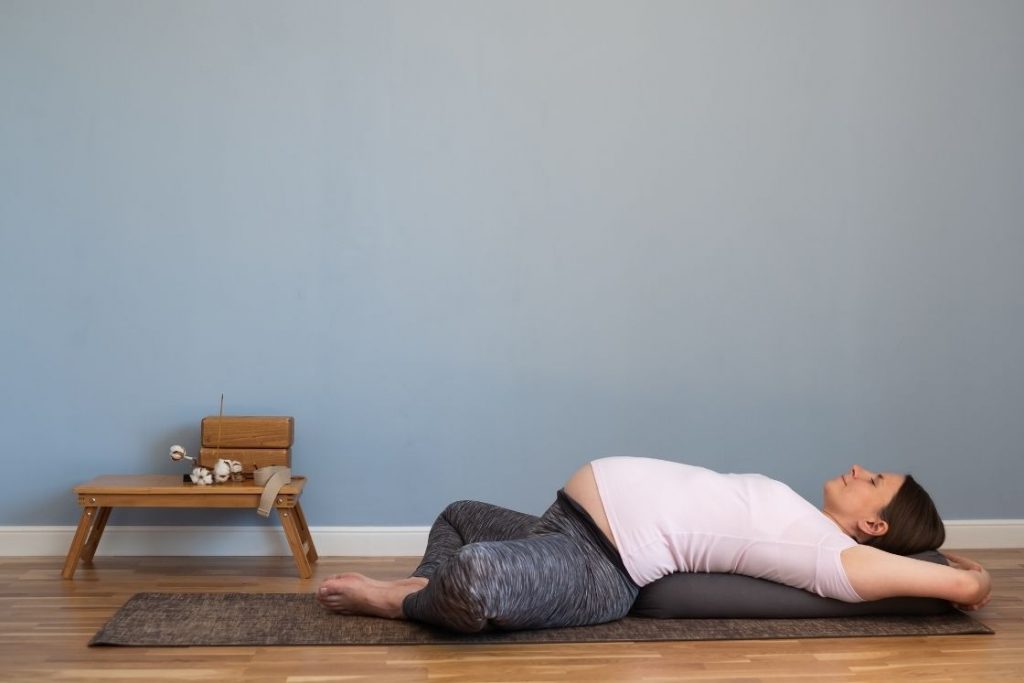
Surya Namaskar is an energizing sequence of 12 poses performing which is a way of paying tribute to the Sun. It is a holistic practice that integrates asana, pranayama (synchronized breathing), and 12 mantras altogether in one sequence.
Coming to its benefits, Surya namaskar is a total body workout – from strengthening the muscles and joints to improving the efficiency of internal organs and detoxifying the body.
With these benefits, the question arises – is it safe to perform during pregnancy?
As pregnancy is a delicate time for women, certain yoga practices are restricted as time passes from the early days to the end of pregnancy. This is because any small anomaly, strain, or injury can harm the woman’s body and her unborn baby.
So is it alright to perform an energizing and fast-paced surya namaskar during pregnancy?
Let’s find out.
Is it safe to perform Surya Namaskar during pregnancy?
The small answer is yes, provided you have been practising it before pregnancy.
A more detailed answer is that; in the 1st and 3rd trimesters, pregnant women have to take utmost precautions when performing Surya namaskar. Certainly, asanas should be modified in a way that can accommodate a pregnant woman’s body and doesn’t create any discomfort.
During the 1st trimester, your pregnancy is at an early stage and the chances of miscarriage are also high. In the 3rd trimester, your belly is protruded significantly which affects your balance and proprioception. Any strain during these trimesters can be dangerous to you and the fetus’ health and growth.
However, during the 2nd trimester, you can easily perform surya namaskar, but at a slower pace. You still need to take precautions with movement and customization of the poses.
Also Read: A Complete Guide for Beginners to Get Started with Sun Salutation
Points to remember to perform Surya Namaskar during pregnancy

Even though the entire phase of pregnancy is delicate and prone to health dangers, the early stages of pregnancy are extremely crucial to the life and health of the mother-to-be and the fetus. You need to be further careful in not straining your abdominal muscles and having discomfort in any part of your body.
For this, you need to take care of the following points before you start performing surya namaskar:
1. Consult your doctor
Before starting surya namaskar, or any other physical practice, you should consult your doctor. Talk in detail about your health, complications, things you should and shouldn’t do, etc. Be sure of all things that are necessary for your pregnancy.
2. Do not start a new practice
If you have not been performing surya namaskar before pregnancy, you should not start your practice now. Doing something new can cause strain or discomfort which should be avoided. You can customize your practice if you have already been practising surya namaskar or any other yoga practices.
3. Be slow and gentle with your body
This goes without saying that the pace of performing surya namaskar during pregnancy should be slowed down to an acceptable pace.
You must carry out each of the 12 asanas slowly and deliberately. If you experience any kind of discomfort or suffering, do not force yourself to do any asanas. Use props and support during practice. And if you just are not comfortable doing an asana, it is better to skip or modify it rather than force your body to perform it.
4. Take professional assistance
Many prenatal yoga classes cater to performing yoga for a pregnant woman.
It is better that you enroll in such classes as they will tell you exactly how you can practice surya namaskar without harming your body and fetus. If you do not have any such classes nearby, search for online classes or experts that can teach you a modified version of surya namaskar. Since they are trained in teaching pregnant women, they are better equipped with the knowledge and know-how of performing yoga.
Also Read: Prenatal Yoga Poses for Pregnancy, Benefits, Safety Tips
5. Make a habit of regular practice
Unless you have some complications in your pregnancy, make sure you are continuing with your practice regularly. Even if you have to perform it at a much slower pace than you are used to, you will still get the benefits of surya namaskar. Do not perform it randomly.
6. Listen to your body
A woman’s body is going through a ton of changes every day, especially during pregnancy. You must listen to your body when performing surya namaskar. Be cognizant of any discomfort, pain, strain, or stress in any part of your body. You should even take into consideration your mental changes. If you are not feeling up to it, you should avoid practising it rather than forcing yourself.
7. Never skip savasana
The importance of savasana (corpse pose) cannot be stressed enough.
When you lay in corpse pose after sun salutation, you are not merely lying down, you are giving time to your body to soak in all the energetic changes the practice of surya namaskar has brought to your body. You are giving time to your mind to release stress, tiredness, fatigue, and anxiety.
It is the final step before you get up and start your day. This is also the time when you can spend some time with your unborn baby and connect with it.
How to Do Sun Salutation During Pregnancy – A Modified Sequence
The traditional sun salutation yoga poses can be modified to feel more comfortable and to better prepare your body for birth as your tummy grows. These can be incorporated into your daily life at any point during your pregnancy.
- Begin by standing with your feet spread more than hip distance apart in Mountain pose (Tadasana). The distance between your legs can be as per your belly growth or the need of the hour.
- To enter urdhva hastasana (upward salute), inhale and raise your hands and extend your arms upward. Join your hands or keep them separated at your convenience.
- Exhale while bending your knees and hinging forward from your knees to perform modified Uttanasana (Standing forward bend). While keeping your knees bent, place your hands between your feet on the mat or your shins. You can also keep your hands in Anjali mudra with your elbows on your thighs.
- Inhale and take your right leg back for the Ashwasanchalasana (low lunge). Your left hand can be placed outside the left leg to create more space for your belly in the later months. Bending the knee of the right leg and placing it on the mat is also acceptable. Moreover, taking the right leg further towards the right will also create space for your abdomen.
- Exhale and move your left leg back for the plank pose (phalakasana). If you do not want to put pressure on your body, lower your knees gently onto the ground to perform this pose. If you perform the traditional plank, do not hold this pose for a longer duration.
- It is better to skip Knees-Chest-Chin Pose (Ashtanga Namaskara) and Cobra Pose (Bhujangasana) to avoid any strain on the abdomen and lower back. After the plank, inhale and pause for a few seconds and move on to the next pose.
- Exhale and lower your arms for chaturanga dandasana (four-limbed staff pose). Even for this pose, you can lower your knees to the ground, if you were not doing it in the plank pose.
- Inhale and come back to the plank position with your knees still on the ground. You also have the option of skipping the chaturanga dandasana if it is uncomfortable.
- Exhale and gently lift your hips and knees to come to a downward dog pose (Adho Mukha Svanasana). Keep your legs wider apart for balance and stability. In the later months, you can either avoid this pose or practice the milder tabletop variation.
- Inhale and bring your right foot forward for Ashwasanchalasana (low lunge). Follow the same process of hand place meant as you did initially. If your foot doesn’t reach the front of your mat in a single motion, that’s okay. If required, take a few little steps or move it along with your hand.
- Exhale and slowly bring your left leg to the front with the right leg. Place the left foot outside the left hand. Keep your hands on the mat with your knees bent. Just like the initial modified Uttanasana (Standing forward bend), place your hands either on the mat, your shins, or in anjali mudra with elbows on your thighs.
- Inhale and gently straighten your legs while extending your arms overhead urdhva hastasana (upward salute).
- Exhale and lower your arms for the mountain pose (tadasana).
If you feel comfortable and repeat the entire sequence with the left foot. In case you are feeling drained or exhausted, one round is more than enough. Lie down in savasana for some much-needed rest.
Benefits of Surya Namaskar for pregnancy

Even though you are performing modified surya namaskar, the benefits you gain out of it are the same as the traditional practice. You are gifted with a calm and relaxed mind with a supply of energy throughout the day. This further helps in managing your mood swings and keeping up with hormonal changes. A relaxed mind leads to a healthy heart that keeps away problems like hypertension.
There are many more benefits, which have been listed below:
- Enhances blood and oxygen circulation as a result of synchronized inhalations and exhalations.
- Helps manage and reduce stress by boosting the production of hormones and calming the mind.
- Aids in adapting to physical and mental changes by calming and relaxing your mind and encouraging you to embrace the changes.
- Prevents frequent mood swings by stimulating the endocrine system favorably and bolstering hormonal balance.
- Assists in weight management as you stretch and strengthen all the muscles of your body making up for good physical exercise.
- Alleviates back and leg pains as the continuous flow of asanas relieve you of ongoing muscular aches and pains by strengthening your back, legs, and core muscles.
- Provides energy throughout the day by connecting body, mind, and breath when performed in the morning.
- Prevents pregnancy-induced hypertension as the combination of asana with breath strengthens your cardiovascular system which controls your blood pressure.
- Prevents the onset of gestational diabetes by improving the production of insulin and reducing blood sugar levels.
- Prepares the body for childbirth as it makes your body flexible and trains your mind to stay calm in stressful situations such as labor pain.
- Improves your sense of coordination, proprioception, and balance.
- Can improve the quality of sleep in the later stages of pregnancy.
- Promote glowing, well-nourised, and healthy skin and hair.
Conclusion
Pregnancy does come with a lot of changes and one of those changes can be to perform a modified surya namaskar. If you have been doing it even before you became pregnant, and have no complications, you just need to tweak it a little bit. The benefits you will get will make this phase easy to handle.




